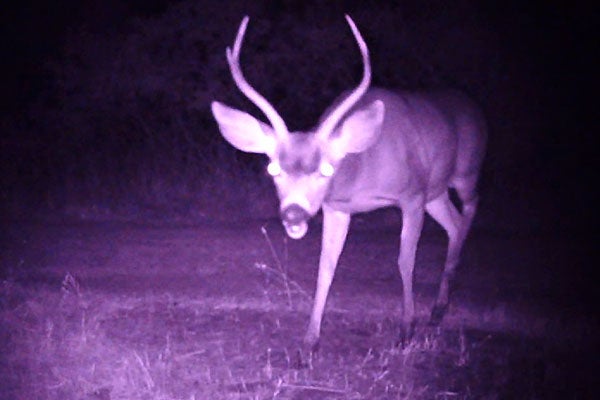|
View video here.
June 1, 2012
Caught on tape: The nightlife of animals at Stanford's Jasper Ridge preserve
Motion-activated cameras at Jasper Ridge Biological Preserve provide scientists a window into the secret lives of the animals there. Some, like the hummingbirds, flit about during the day. Others come out at night. Among the cast are mountain lions, bobcats, deer, coyotes, foxes and skunks. By Katy Ashe

Captured by a camera: A buck checks out the equipment. (Image courtesy of Jasper Ridge Biological Preserve) Motion-activated cameras at Stanford's Jasper Ridge Biological Preserve allow researchers to watch their world of animals like never before. The solar-powered cameras automatically record video or photographs when a creature is in the vicinity; night vision means the scientists never miss a moment. The researchers have an opportunity to observe animals going about their usual business, away from the world of human disturbance.
Videos and photos are instantaneously uploaded, thanks to a new wireless network infrastructure that covers almost the entire preserve – 1,200 acres in the Santa Cruz Mountains, 3 miles west of the Stanford campus.
Footage of skunks, possums, raccoons, mountain lions, deer, jackrabbits, hummingbirds, bobcats and many others sheds light on the wonderful biodiversity in the preserve.
"We are getting all of the types of animals that we expect to find in the area, including some that we don't often see in person, such as the gray fox, which is rarely seen in the daytime at Jasper Ridge," said Trevor Hebert, data manager at the biological preserve.
"The video cameras are giving us a picture of a world that we never see," he said.
Mostly, the cameras capture animals going about their regular nightly business, usually walking or running. "The typical skunk, coyote, bobcat, gray fox, possum, raccoon or rabbit seems to move at between a brisk walk and a jog almost constantly, at least when traveling," said Hebert.
"Deer tend to move slowly and cautiously, often feeding as they go, unless they are spooked by something."
"Personally, it's fun to see the interactions," said Stanford conservation biology doctoral student Eric Abelson. The cameras capture footage of bobcat cubs playing with one another, a bobcat playing with a freshly caught wood rat by tossing it far into the air, even territory wars between different species. In one set of images a mule deer intimidates and chases coyotes into the bushes.
"Most people think that deer don't have a lot going on in their heads, but deer are quite curious and quite aware of their environment," said Hebert. "Especially the young ones will investigate anything new in their environment, including the cameras when they are first put out. There is an interesting video of a large buck sticking its nose into the lens of the camera."
The sweetest nectar a hummingbird can find
The cameras are also used to answer direct research questions. For example, Assistant Professor Tadashi Fukami, biology, uses video cameras to record the patterns of hummingbird visits to sticky monkeyflowers (Mimulus aurantiacus) at the preserve. The focus of the research isn't so much about the hummingbirds as it is about the tiny microbes that hitchhike between the flowers on a hummingbird's beak.
When the flowers are new the nectar is free of microbes. "A new flower is like an uninhabited island," said Fukami, "but when the hummingbirds come, they bring microbes that colonize this new flower."
He and his colleagues study the way that these new microbial communities assemble in the nectar of flowers, as reported in Microbial Ecology and the Proceedings of the Royal Society B.
Their research asks fundamental questions about the diversity of the colonizing microbes, how that diversity is maintained and the dynamics behind community formation. "We can use this research to think more generally about what this means for the community assembly," Fukami said.
The cameras allow this group to make subtle observations they had missed before. "By using the cameras we realized that hummingbirds like to go to the unopened flowers," Fukami said. "We used to assume that they waited for the flowers to bloom, but they like to poke into unopened flowers to get fresh nectar."
The new camera traps allow biologists to gather more data on the animals of Jasper Ridge than ever before – more data than a human can process.
"Some of the excitement wore off after processing the first 200,000 images," said Abelson. In response, Abelson teamed up with a computer science research group. Together they developed a tool that aids in rapidly processing and tagging images from the cameras. This new tool automates the most time-consuming part of Abelson's research and allows him to focus his team's efforts on the science.
Katy Ashe is an intern at the Stanford News Service.
-30-
|